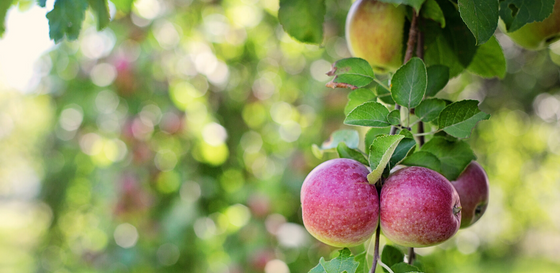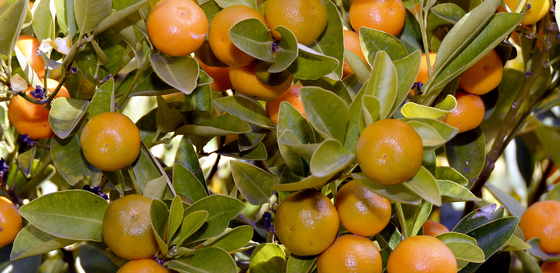
Our nursery staff have prepared a few tips and advice for these Summer months to encourage your fruit trees to thrive:
There should be quite a lot of growth from your tree/s during the hotter months. We trust that you have been balancing your tree and shaping each of the grafts so they grow in their own separate areas. Make sure one or two grafts are not outgrowing the others and trying to dominate the tree. Keep the branches even, so the tree remains balanced and the amount of fruit from each graft will be similar.
How do I balance it again?
Establish a well 'balanced' tree by pruning back the more vigorous growing grafts, anytime during the growing season. Check it every month. It’s especially important while the tree is young and developing!
Keep each graft confined to grow in its own area/side of the tree; this will assist in recognising the faster and slower growers. Depending on how many different fruit grafts are on your tree, for example if it’s a Stone fruit tree and you have three grafts on the tree, then grow the branching of the peach graft to one side of the tree, the growth of the plum to the other side of the tree and the growth of the nectarine to another side. Separate their growing areas so you can distinguish them from each other which then enables you to ‘balance’ and keep their growth even.

Tip: Don't just look at how long branches are and compare, also look at how many branches each graft has. If one graft has 6 branches and the others less, then cut some of the branchings of the bigger one because more energy is being stored in that graft. The thickness of the branch coming from the main central stem of the tree is an indicator of how much energy it’s consuming.
Make sure you vary the diet a little. Slow release fertiliser is good (Osmocote or Plantacote with added trace elements). Animal manure i.e. cow, sheep, horse, chicken (older is better)] is great because it's natural. Compost, trace elements, blood and bone, and all-round fertilisers are also good.
Caution: When using fertilisers, keep away from direct contact with the trunk of the tree.
If you live in a frost prone area, then it is best not to fertilise late Autumn because this can encourage new growth that can be burnt off with frost.
Top up mulch when required. Around 10cms of mulch is good to keep the moisture levels of the soil consistent. From time to time you can add kitchen scraps under the mulch to attract earthworms (although dogs can dig them up).
Don’t use just straight grass clippings as it will heat up and possibly ‘cook’ or overheat the roots. Mix it with dry older leaves, twigs, etc.

We hope you have identified the different grafts you have growing from the main central stem of the tree (e.g. using a dab of ‘white out’ paint) so that you can easily identify them and so you don't accidentally cut them off.
Check and remove all other growth (rootstock) emerging from the central stem. This is rootstock growth and it doesn't produce worthwhile fruit. Always cut out the growth that comes from the ground from any fruit tree. All the energy needs to be going into the grafts, not the rootstock.


Hint: Citrus rootstock looks very different from the grafts as it has long sharp thorns and a small three-pronged leaf.
You can purchase netting from nurseries and large hardware stores such as Bunnings. Net your tree to prevent fruit and branch damage from birds and bats.
Apples ripen February – March (weeks apart)
Hint: If you think the branches will break under the weight of the fruit, take some of the fruit off so the energy will go back into the tree and grow stronger branches for next year’s crop.
How do you know when they are ripe and ready to pick? Leave on the tree to ripen, pick when they easily come off.
The size of the trees when sent are approximately between 40cm-70cm. Trees are grown so that the fruiting branches begin from approximately 10cms above soil level, keeping the height to a minimum, which allows easy harvesting.
Apples are grown on standard rootstock which means the tree has grown in the ground as ‘stand-alone’. Your Apple Fruit Salad Tree will grow approximately 2.5 metres (7-8ft) high x 2 metres (6ft) wide. It is recommended to grow them by the espaliered method to support the branches for heavy cropping eg. along with a trellised wire, a fence/wall. In the best conditions (e.g. warm coastal climate, plenty of fertiliser, water), these trees grow approximately ½ metre per year, less if in a colder climate.
Their fruiting season spreads over a maximum of 3 months, depending on how many fruit grafts are on the tree.
The season begins from around December through to February. A tree with more than one variety of the same type of fruits e.g. Peaches (white and yellow), means they will ripen a few weeks apart. They don’t produce all year round because they are deciduous trees, dropping their leaves late Autumn and going dormant for a couple of months.
Fruiting time (these time frames are a guide and can slightly vary depending on climate conditions)
Apricots: December
Peachcots: January to February
Nectarines: Mid January
Peaches: Late January
Plums: February

How do you know when they are ripe and ready to pick?
Apricots, Nectarines, Peaches, Plums and Peachcots are all best ripened on the tree and pick them when they easily come off.
The size of the trees when sent are approximately between 40cm-70cm. Trees are grown so that the fruiting branches begin from approximately 10cms above soil level, keeping the height to a minimum, which allows easy harvesting.
A Stone fruit tree grown in the ground will grow approximately 3 metres (10ft) high x 2 metres (6ft) wide. In the best conditions (e.g. warm coastal climate, plenty of fertiliser, water etc.) these trees grow approximately 1 metre per year.
During late Summer if the leaves are getting brown on the outside and may have brown or red spots or dry looking around the edge of the leaf, looking old, brittle and dry or changing colour and falling off, then the tree is thinking about dropping its leaves. This is normal because Stone fruit trees are deciduous and drop all their leaves late Autumn for dormancy, there is no need for alarm. The tree is not dying, just having a rest after all its hard work last growing season!
Be sure to give the tree the usual clean up spray of Lime Sulphur for your Stone Fruit trees once all leaves have fallen for Leaf Curl disease prevention, by mid-May! This has been outlined on the Care Leaflet for the tree.
Citrus can produce all year round because they are evergreen and active all year. If your tree has the two different oranges, for example, one will produce during Winter months and the other during the Summer months.
Fruiting time (these time frames are a guide and can slightly vary depending on climate conditions)
Lemon: most of the year round (especially warmer climates)
Oranges: Valencia – summer, Washington Navel – winter
Pomelo: Winter (long picking season)
Mandarin: Autumn – early Winter
Lime: Autumn – Winter
Grapefruit: Winter (long season)
Tangelo: Winter (long season)
Lemonade: Late Winter

How do you know when they are ripe and ready to pick?
Citrus does not ripen off the tree and is not always ready to eat when the fruit has coloured up. Citrus fruits are ready when they are easily picked off the tree. It’s best to try one and if you have to really pull and twist, then they are not ready yet.
The size of the trees when sent are approximately between 40cm-70cm. Trees are grown so that the fruiting branches begin from approximately 10cms above soil level, keeping the height to a minimum, which allows easy harvesting.
The citrus trees are grown on dwarfing rootstock which means the tree grown in the ground will grow approximately 2 metres (6ft) high x 2 metres (6ft) wide. In the best conditions (e.g. warm coastal climate, plenty of fertiliser, water etc.), these trees grow approximately ½ metre per year, less if in a colder climate.
Keep up the good care for bountiful fruits and enjoyment!
For more information on planting your Fruit Salad Tree in the ground, click here.
As your tree grows, fertilise about four times a year, remove rootstock, balance your tree and thin the first fruit.
Happy harvesting!
We stock a wide range of Fruit Salad Trees, which all boast different fruit on the same tree. Each fruit variety retains its own flavour, appearance and ripening time. We graft citrus, stonefruit and multi-apple trees.
Our fast fruiting trees can be grown in the ground, or in pots on your balcony.
Shop our wide range of trees now and check out our current specials here!
Comments will be approved before showing up.

How does your edible garden grow? Whether it's a balcony garden, a backyard oasis or an extensive orchard, there are a number of items that will help you grow your delicious, fresh kitchen ingredients. Growing a multi-grafted fruit tree isn't as simple as sticking your tree in some dirt and walking away, but they are pretty easy to grow!

Here are some tips to help you keep your Fruit Salad Tree at it's best throughout the year. We all get busy and sometimes the garden jobs get forgotten. We get it!
We've popped these tips and tricks into categories (eg Citrus or Apple or Stonefruit) and then into seasons (eg in autumn remember to do this or keep an eye out for this in summer, etc.) to make things as easy as possible.
Happy, healthy fruit trees grow more fruit and that will make everyone happy!

There are many ways that you can become more sustainable and growing your own beautiful fruit tree at home is a great way to start!
In this short video, Kerry shows her veggie garden and the different types of Fruit Salad Trees to compliment edible gardens big and small.